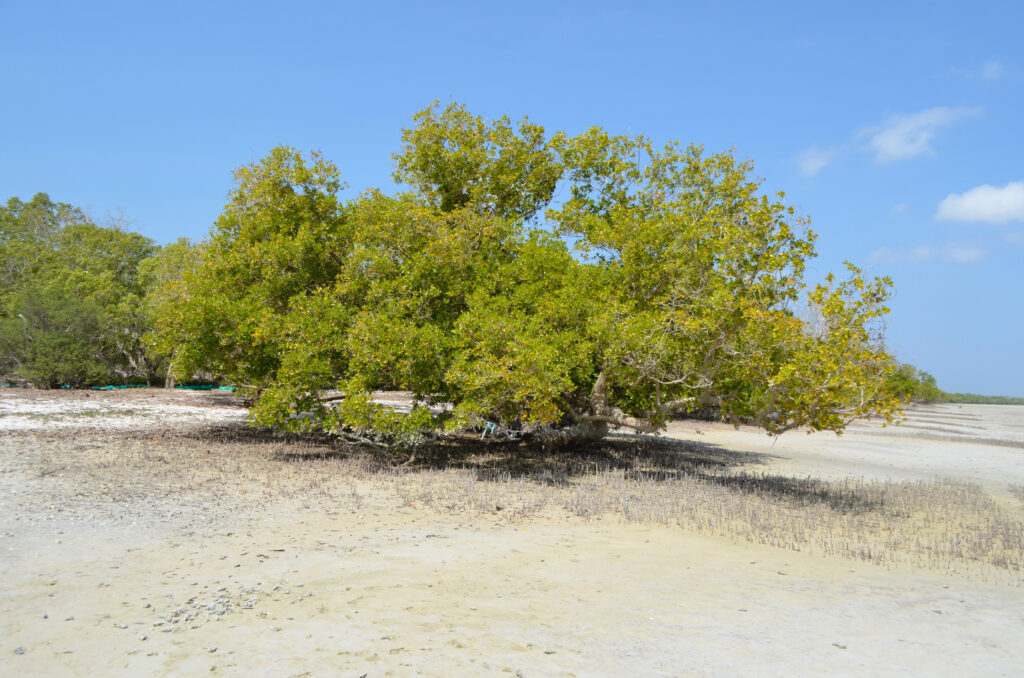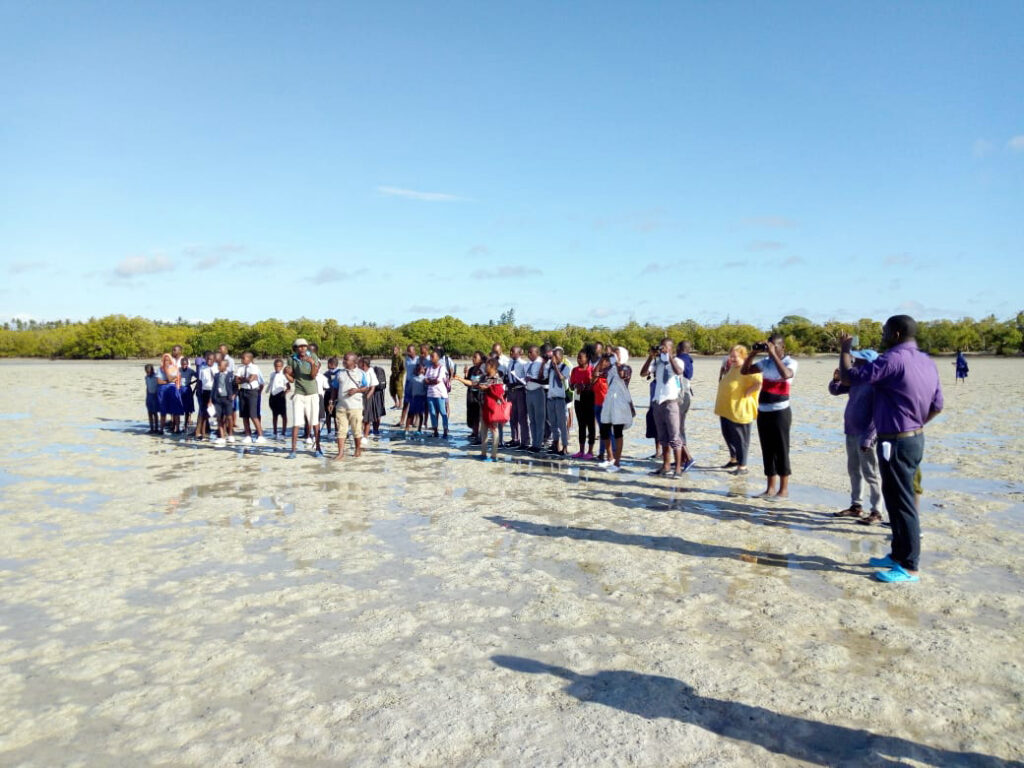Kenya’s hotspot for migrating waders: Mida Creek

Kenya lies along the African-Eurasian flyway, an important international route for migratory birds. About 170 Palaearctic migratory bird species migrate south to Kenya from Europe and Asia.
By Caroline Chebet
A blend of red, orange and yellow paints the sky whilst the setting sun casts silvery glitters on the vast expanse of Mida Creek, a tidal inlet in Kilifi County. On the beach, hundreds of silhouettes of birds move with the constant ebb and flow of waves. A suspended boardwalk cutting through the dense thicket of mangrove forest completes the charm of this special place tucked within Kenya’s North Coast.
All around the boardwalk, which opens up to the sea at the end, is a rich concentration of mangroves. Of Africa’s nine species of mangroves, Watamu’s Mida Creek boasts eight, making it an important breeding and feeding ground for marine species.
“Mida Creek is a place rich in biodiversity. This creek attracts tourists and researchers who come to learn more and study the complex marine ecosystem” , says Ali Bakari, the chairperson of Mida Creek Conservation and Awareness Group (MCCAG).
From the boardwalk, one can discover the many aspects of Mida Creek: mud and sand flats, open shallow waters and mangrove forests. It is these diverse habitats and the birds and marine life they sustain that give Mida Creek global recognition. Together with the adjacent Arabuko-Sokoke Forest, Mida Creek is part of the Malindi-Watamu UNESCO Biosphere Reserve – terrestrial, marine and coastal ecosystems that promote the reconciling of conservation of biodiversity with sustainable use.

The mangrove channels form important feeding and breeding grounds for various fish species, including parrotfish, rabbitfish, jacks, snappers, groupers, emperors, and barracudas. Mida Creek is also an important passage and wintering ground for Palearctic migrant waders, hosting thousands of migratory and resident birds, including regionally and globally threatened species.
Designated as an Important Bird Area , the creek hosts large congregations or gatherings of Greater Sand Plover (Charandrius leschenaultia) Lesser Sand Plover (Charandrius mongolus), Grey Plover (Pluvialis squatarola), Sanderlings (Calidris Alba), Curlew Sandpipers (Calidris ferruginea), Whimbrel (Numenius phaeopus) and Little Stint ( Calidris minuta). Additionally, the creek is a significant feeding area for Western Reef-egeret (Egretta gularis ), Lesser Crested Tern (Thalasseus bengalensis) and the Roseate Tern (Sterna dougallii ).
Kenya lies along the African-Eurasian flyway, an important international route for migratory birds. About 170 Palaearctic migratory bird species migrate south to Kenya from Europe and Asia. The 550km long coastline and its associated creeks, reefs and beaches also form part of the country’s major migratory flyways. Another crucial migratory corridor is the chain of Rift Valley lakes stretching from Lake Turkana in the north to Lake Magadi in the south. Kenya is a party to two international treaties which protect migratory birds: the Convention on the Conservation of Migratory Species of Wild Animals (CMS) and Agreement on the Conservation of African-Eurasian Migratory Waterbirds (AEWA).
With a pair of binoculars, one might observe Lesser Crested and Roseate Terns feeding. Between September and May, one can also spot Curlew Sandpipers, Little Stints, Whimbrels, Grey Plovers, Greater and Lesser Sand Plovers.

In the water, marine life includes varieties of seagrass and seaweeds that provide food and habitat for other aquatic species. Among the mangroves, one can spot fiddler crabs with one big bright claw carpeting the sand.
Nature Kenya Coast Regional Coordinator Francis Kagema explains the need to keep the creek’s environment healthy to support its large number of birdlife and marine species. “To sustainably conserve the creek, we rolled out livelihood empowerment programs that involved building the capacity of local communities to enable them to tap from tourism and conserve Mida Creek”, Kagema says.
The Mida Creek Conservation and Awareness Group is the area’s Site Support Group (SSG) which is actively engaged in conservation activities around the marine wetland. It’s members, in partnership with other stakeholders, conduct waterbird counts in January and June each year. These counts are meant to establish the number of waterbird species, including migratory waders, at Mida Creek and their estimated populations. Volunteers from the SSG, together with a team from A Rocha Kenya, conduct these counts. Visitors are also allowed to join in the exercise for a fee.
“Through the waterbird counts our members and visitors get to learn more about migratory birds and their importance to the environment”, says Ali Kibwana, a member of the SSG.
“Migratory birds, just like elephants, lions, and wildebeests, are a major tourist attraction here. These birds deserve protection just like any other wildlife”, he adds.
Members of the SSG also conduct monthly bird monitoring, regular beach cleanups and mangrove planting, among other site activities. In 2022, the group planted 2,100 mangrove seedlings in degraded areas of the creek as part of their habitat restoration initiative. Looking ahead, Mida Creek Conservation and Awareness Group aims to sustain the protection of the creek by inculcating conservation knowledge among children. In this regard, the group regularly conducts environmental education and awareness creation activities targeting school pupils.
To support community livelihoods, the group is engaged in income-generating activities. These include ecotourism, where members offer tour guiding and boat riding services to visitors. Nature Kenya has supported the group with life jackets and other marine safety gear. The group also runs a restaurant.
“Mida Creek not only supports biodiversity but also our livelihoods”, concludes Kibwana.
“To sustainably conserve the creek, we rolled out livelihood empowerment programs that involved building the capacity of local communities to enable them to tap from tourism and conserve Mida Creek”Francis Kagema, Nature Kenya Coast Regional Coordinator
